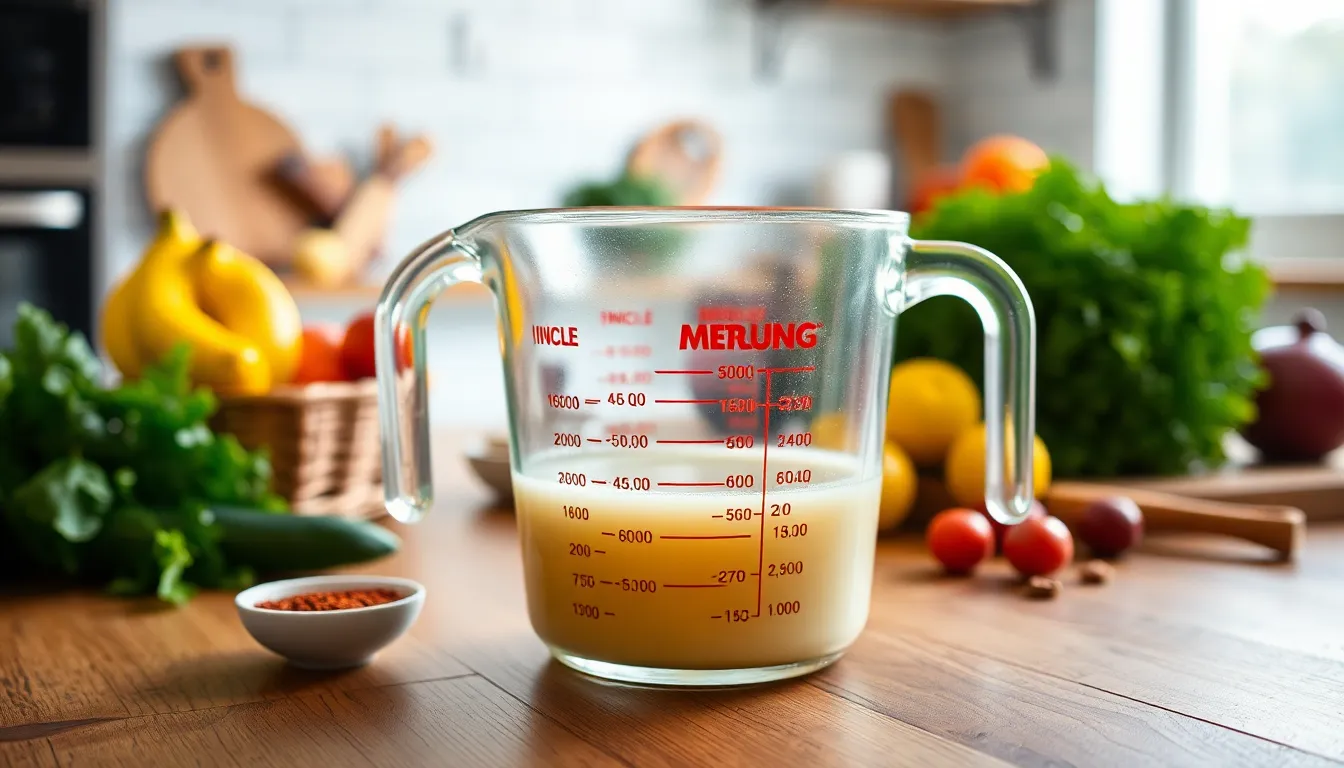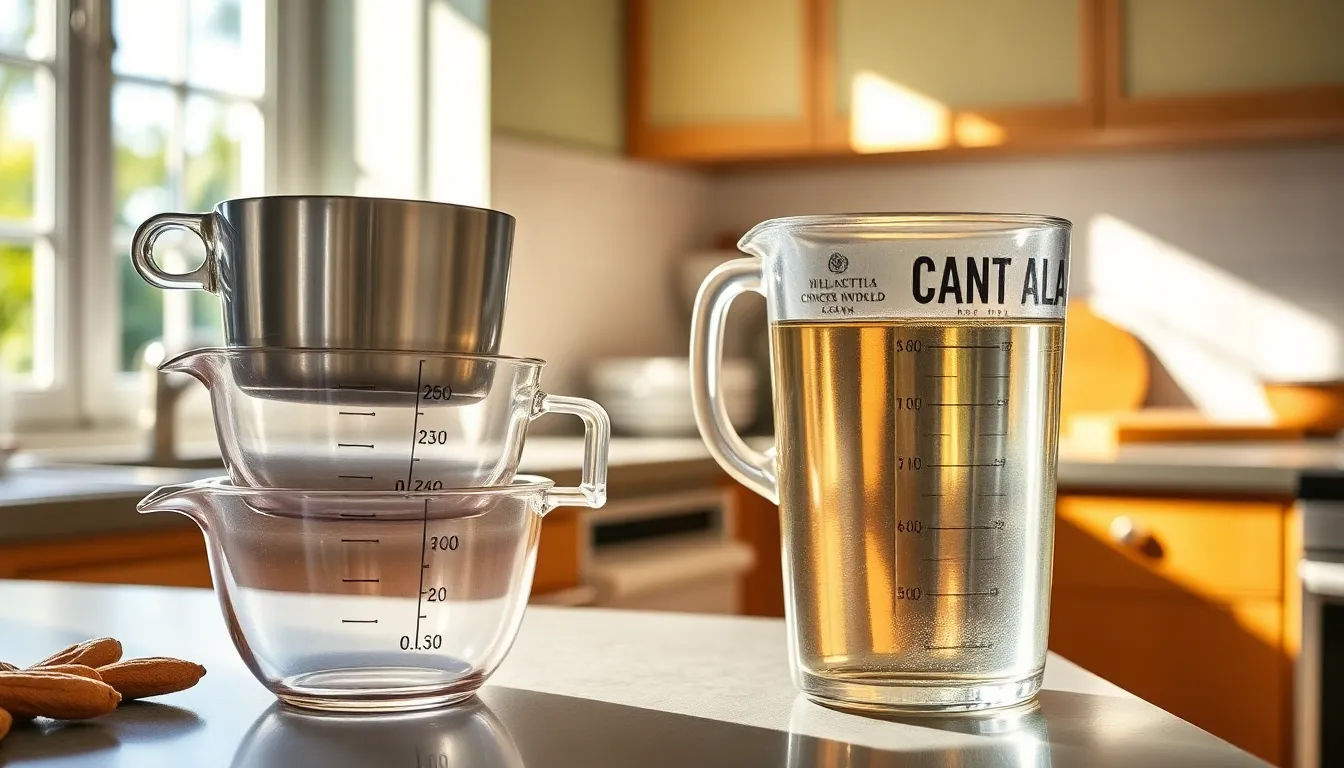When diving into the world of cooking and baking, measurements can feel like a foreign language. Ever found yourself staring at a recipe that calls for quarts and cups, wondering if you need a degree in math just to whip up a batch of cookies? Fear not! Understanding how many cups are in a quart is simpler than it sounds, and it might just save your next culinary adventure from becoming a kitchen catastrophe.
Table of Contents
ToggleUnderstanding Measurement Conversions
Understanding measurement conversions simplifies cooking and baking. A quart equals four cups. This knowledge proves crucial when following recipes that use different volume measurements.
Different recipes might require various conversions. For instance, when tripling a recipe, knowing that each quart contains four cups saves time and prevents errors. Converting between quarts and cups ensures accurate ingredient quantities.
Measurement is key in culinary practices. It’s helpful to remember that a cup comprises 8 fluid ounces, while a quart holds 32 fluid ounces. This link makes it easier to visualize how measurements relate.
Many cooking tools and recipes use both metrics. Adjusting recipes for personal preferences or ingredient availability often involves these conversions. Accurate conversions lead to consistent results in dishes.
Use a simple formula for conversions: multiply the number of quarts by four to find the equivalent in cups. Similarly, divide the number of cups by four to determine how many quarts that equates to. This straightforward approach makes measuring less daunting.
Chefs regularly utilize conversion charts to streamline the cooking process. Those charts often include common measurements and conversions for quick reference. Keeping a conversion chart handy can assist anyone in the kitchen, reducing the chance ofmix-ups.
With practice, converting between cups and quarts becomes second nature. Familiarizing oneself with these measurements empowers confident cooking and baking. Dishes benefit from precise ingredient amounts, enhancing overall quality and flavor.
The Quart Defined

A quart is a unit of volume commonly used in cooking and liquid measurements. It’s equal to four cups, which simplifies conversions for baking and cooking.
Historical Context of the Quart
The quart originated from the Latin term “quartus,” meaning a fourth. This measurement has been in use since the medieval period. In England, it served as a standard for trade and commerce during the 14th century. By the 18th century, the quart became widely accepted in both the Imperial and U.S. customary systems. Due to its historical significance, the quart remains an essential unit in kitchens and markets today.
Modern Usage of Quarts
In contemporary cooking, the quart is often used for measuring larger quantities of liquids. Recipes frequently call for quarts when preparing soups, sauces, and beverages. Many food products, such as milk or ice cream, are sold by the quart in supermarkets. The quart’s relevance extends beyond recipes; it assists in inventory management for restaurants and food services. Familiarity with this measurement supports efficient cooking practices and enhances meal preparation.
How Many Cups on a Quart?
Understanding the conversion between quarts and cups simplifies cooking and baking. A quart equals four cups, providing a straightforward way to measure liquids accurately.
Standard Measurement Values
One quart contains exactly four cups. Additionally, a quart holds 32 fluid ounces, and a cup contains 8 fluid ounces. These standard values ensure consistency in cooking measurements. Conversions become clear when remembering that multiplying quarts by four yields the number of cups. For instance, two quarts equal eight cups. Familiarity with these measurement values helps cooks efficiently prepare meals.
Practical Applications in Cooking
In cooking, knowing the quart-to-cup conversion aids recipe execution. Many soup and sauce recipes, for instance, require larger quantities measured in quarts. When a recipe requires three quarts, using the conversion shows that it equals twelve cups. This clarity avoids mishaps during preparation, ensuring accurate ingredient ratios. Cooks often reference these measurements to adjust portion sizes or modify servings. Using conversion charts can streamline these calculations, enhancing the cooking experience.
Tips for Accurate Measurements
Accurate measurements enhance cooking and baking success. Understanding common mistakes ensures cooks avoid pitfalls.
Common Mistakes to Avoid
Relying solely on volume can lead to errors. Some chefs might misinterpret a cup measurement as a dry or liquid cup. Misunderstanding conversions, like assuming that two cups equals a quart, can derail a recipe. Skipping a conversion chart may create chaos in the kitchen. Always double-check measurements before adding ingredients. Not using the correct measuring tools can also produce inconsistent results. Using a liquid measuring cup for dry ingredients might yield inaccurate amounts. Measuring packed ingredients, like brown sugar, without leveling off can alter a recipe drastically. Maintaining precision influences the final dish outcome.
Tools for Conversion
Utilizing conversion charts simplifies measurements. Specialty kitchen tools include measuring cups with quart markings for easy reference. Digital scales provide accurate weight-based conversions, especially for lost measurements. Mobile apps support quick calculations during cooking sessions. Flashcards with common conversions can serve as handy reminders in the kitchen. Choosing recipes with consistent measurement units may ease preparation. Relying on high-quality measuring cups enhances accuracy, reducing confusion in multi-step processes. Staying informed about preferred tools promotes efficient cooking practices, ensuring enjoyable culinary experiences.
Mastering the conversion between quarts and cups is an essential skill for any cook. With one quart equating to four cups it’s easier than ever to navigate recipes without the fear of measurement mishaps. This knowledge not only streamlines the cooking process but also enhances the overall culinary experience.
By familiarizing themselves with these conversions and utilizing tools like conversion charts and measuring cups, cooks can boost their confidence in the kitchen. As they practice these skills, they’ll find that accurate measurements lead to better results and more enjoyable meals. Embracing these simple techniques can transform cooking from a daunting task into a rewarding adventure.


